Laminate Flooring FAQ: 20+ Answers to Your Questions
We’ve heard you’ve got questions about laminate. The good news – we’ve got answers to frequently asked laminate flooring questions and DIY solutions for maintenance, installation, and more!
What is Laminate Flooring?
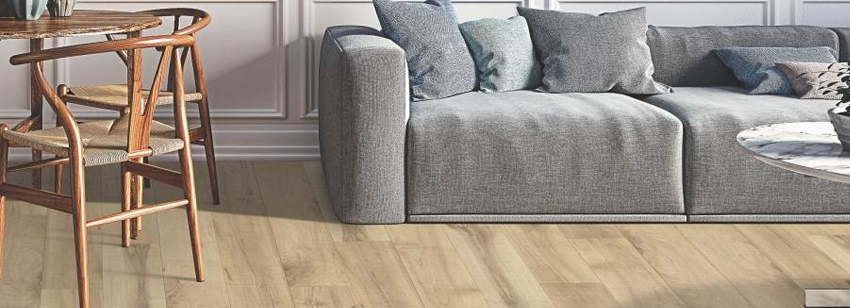
Laminate flooring is a stylish and resilient alternative to hardwood flooring. With advanced manufacturing technology, laminate floors perform better than ever before and come in ultra-realistic designs and textures that mimic expensive wood species at a fraction of the price.
What is Laminate Flooring Made of?
Laminate is often referred to as a “hybrid” floor because of its high-density fiberboard (HDF) core topped with an image layer and wear layer.
- Wear layer: Wear layers are commonly waterproof, protect the floor from scratches and stains, and provide a realistic feel. Wear layers can include rougher, more natural-looking scrapes and knots. For the most hyper-realistic look and feel, explore our embossed in register options, where the image layer and wood-grain wear layer align perfectly.
- Image layer: This holds the pattern or print, making the laminate look like real hardwood and stone.
- Core layer: This layer is typically made of compressed high-density fiberboard, giving the floor durability and stability. It’s resistant to water but not necessarily waterproof. The core layer is also where the locking system is located.
- Backing: The backing keeps water from penetrating the subfloor. A high-quality backing can protect your floor from peaking and moisture damage.
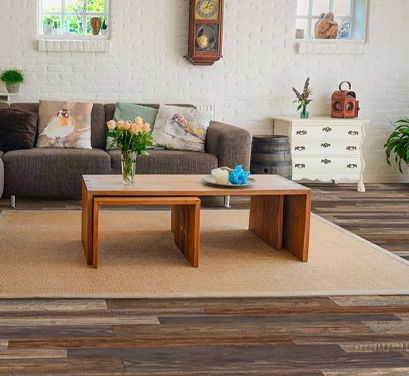
What Are the Advantages of Laminate Flooring?
Laminate flooring comes with several attractive benefits for the home, such as:- Scratch resistance: Laminate can stand up against high-traffic environments, especially for homeowners with young children and pets.
- DIY installation: Laminate’s interlocking plank design allows the flooring to “float” above the subfloor without adhesives, nails, or tape.
- Easy to clean: Maintenance is minimal with laminate, so you’ll always have great-looking floors.
- Realistic feel: Laminate flooring mimics real wood grains and looks for the most realistic experience underfoot. With the laminate’s HDF core, it also holds heat and “walks” like traditional wood flooring.
What Are the Disadvantages of Laminate Flooring?
Although laminate has several appealing perks to it, there are some downsides to be aware of.- Moisure: Traditional laminate can be susceptible to moisture. However, with today’s technology, there are various water-resistant and 100% waterproof laminate options.
- Refinishing: Laminate flooring’s synthetic construction does not allow it to be refinished like solid wood.
How Thick Should My Laminate Flooring Be?
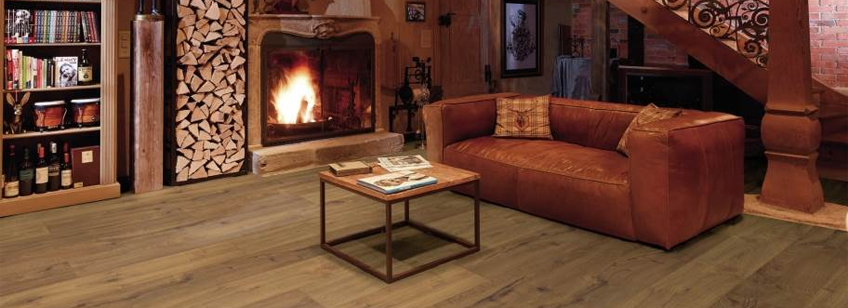
We know your investment in laminate flooring is important. You deserve flooring that stands up against wear, feels comfortable underfoot, and doesn’t appear cheap. With that in mind, we highly suggest laminate options between 10mm to 14mm thick.
Although laminate floors can be as thin as 6mm, the quality and durability of the material don’t perform anywhere near the thicker options.
Benefits of Thicker Laminate Flooring
- Quieter underfoot and with less echo
- More natural hardwood feel
- Increased impact resistance
- Realistic wood etching and aging features
- Ability to hide subfloor imperfections easier
What Does the AC Rating for Laminate Flooring Mean?
The Abrasion Class (AC) rating determines how much traffic your laminate flooring can handle. To find the best laminate option for areas around your home or business; follow the ratings below:- AC1: Sufficient for bedrooms and closets.
- AC2: Perfect for family rooms, living rooms, and dining rooms.
- AC3: Great for high-traffic residential spaces and light commercial use.
- AC4: Fantastic for residential spaces and commercial areas with medium foot traffic
- AC5: The best option for heavy commercial applications.

What Is the Difference Between Laminate and Vinyl Flooring?
Both laminate and vinyl flooring are reliable options for your home. In a way, they are close cousins, providing equally easy installation, competitive pricing, and similar wood looks.One main difference with vinyl flooring is that it’s made of 100% synthetic material and has a PVC or SPC core, making it more suitable for high-moisture areas. Additionally, the range of vinyl thicknesses is a bit more extensive than what laminate can offer.
Are Laminate Floors Waterproof?
Yes, many laminate floors are waterproof! The great news is that you can choose from various water-resistant and waterproof options to find what suits your needs best. Waterproof laminate does not allow any moisture to penetrate, no matter how much time has passed. Water-resistant laminate, although highly resistant to moisture, can soak in liquids eventually if left unattended.
Depending on where you intend to install your floors, 100% waterproof laminate flooring can offer the most resistance to damage in moisture-prone areas of the home. In addition, cleanup is simple with waterproof laminate, as liquids stay on top of the surface. Wipe them away when you get the chance for stain-free floors.
Benefits of Waterproof Laminate Floors:
Depending on where you intend to install your floors, 100% waterproof laminate flooring can offer the most resistance to damage in moisture-prone areas of the home. In addition, cleanup is simple with waterproof laminate, as liquids stay on top of the surface. Wipe them away when you get the chance for stain-free floors.
Benefits of Waterproof Laminate Floors:
- Their waterproof core is less susceptible to swelling and lifting from the subfloor.
- A water-repellent seal that prevents moisture from reaching the core of the floor.
- Some waterproof laminate plank floors come with beveled edges that help keep moisture from the cracks between planks.
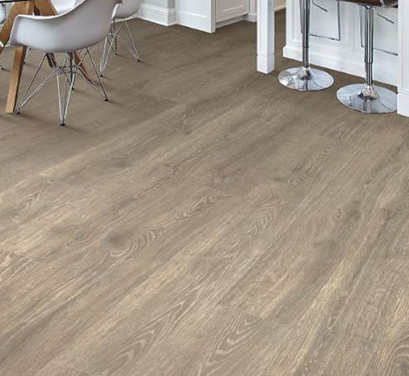
How Long Does Laminate Flooring Last?
Most of our laminate floors come backed with an extensive warranty ranging from five years to a lifetime guarantee. With proper care, your laminate can look beautiful in your home for years of enjoyment.When shopping for laminate flooring, we find it helpful to compare the AC ratings of the laminate you’re interested in. Floors of a higher AC rating of 4 or 5 are commercially rated and therefore made to withstand tougher conditions for more extended and up to 20 to 30 years.
How to Install Laminate Flooring

You can install laminate planks easily, thanks to the interlocking tongue and groove systems. Your laminate flooring will “float” directly on top of your subfloor without the use of grout, glue, adhesives, or extensive installation tools.
Where Can I Install Laminate Flooring?
You can install laminate above and below grade and practically anywhere in the home. We recommend waterproof laminate for high moisture areas, like the kitchen and bathroom, and suggest that you clean up any water or spills right away. If you’re a business owner and are interested in laminate floors, we have heavy commercial options that can stand up against heavy foot traffic and resist scuffs and dents.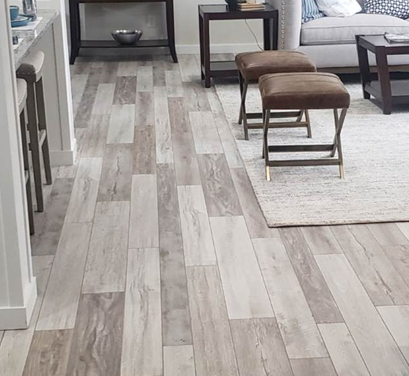
Does Laminate Flooring Need Underlayment?
Yes! For the best results, you must use underlayment with an attached vapor barrier underneath your flooring. Underlayment provides several benefits, such as sound absorption, insulation, and protection against moisture.Some of our laminate flooring options include an attached underlayment. If not, we have a variety of foam and cork underlayment options available for you to choose from.
Additionally, If you intend on installing laminate flooring over concrete floors, you must have a vapor barrier. Concrete is porous, and a vapor barrier will prevent moisture from coming up from the subfloor, potentially ruining your laminate.
Where Can I Install Laminate Flooring?
Besides your chosen underlayment and laminate flooring, you’ll need various tools for installation, such as a:- Pen
- Tape measurer
- Knee pads
- Rubber mallet
- Tapping block
- Flooring cutter
- Spacers
- Wide-angle pull bar
- Tongue and groove adhesive
How Do You Lay Laminate Flooring?

After gathering the right tools, you can begin installing your laminate flooring.
- Start the installation by placing the first plank in the corner of the room, working from left to right.
- With the tongue and groove connectors and seams aligned, connect the first row.
- Continue to lay your laminate flooring, making sure to use the tapping block and rubber mallet to keep the planks locked into position.
- When you come across a wall/door jamb and need to cut the plank, measure the space and mark with a pencil or chalk for where you want to cut. Then, use a tile cutter or table saw to cut the excess of the plank for a refined edge.
- If you have any cut ends 6” or longer, you can use those to begin your next row. You can stagger the planks to give them a natural wood floor look.
- Set the next plank into the previous row at a slight angle to ensure it interlocks properly.
- Continue down the room, checking to ensure planks are interlocked and seams have a snug fit. Add spacers every couple of feet around the edges of the flooring, and remove them when you’re done installing.
Note: For a more seamless appearance around expansion gaps, you may choose to add a quarter-round molding to cover them up.
How Do You Cut Laminate Flooring?
You can cut laminate planks with a jamb saw, or a table saw with an attached laminate blade. Anticipate one to two hours to cut them on your own.- Measure where you want to cut your laminate and mark a line with chalk or pencil
- Hold your board steady in place, using a stand or clamp.
- With your table saw or jamb saw, make straight cuts through your laminate. For detailed or angular cuts, we recommend using a jigsaw or utility knife.
Safety Tip: Keep your hands steady and away from the blade at all times. Wear safety gloves, goggles, and a face mask to protect yourself from laminate chippings. For more safety tips, visit Homes.com for things to look out for during every step of your renovation.

Do You Need to Seal Laminate Flooring?
No, you do not need to seal laminate flooring. Your laminate comes with a wear layer that protects against stains and scratches. Adding additional sealant to your laminate could damage your floors and potentially make it more slippery to walk on. Make sure to check with the manufacturer for individual product recommendations.How to Clean Laminate Flooring

One of the most fantastic perks of laminate flooring is the easy cleanup compared to other intensive floor types. Explore below for the best ways to keep your floors feeling fresh underfoot and help them retain their beautiful shine.
How Do You Clean Laminate Flooring?
For weekly maintenance, sweep your floors with a soft-bristle broom to clean off dust, debris, and leftover crumbs. Then, with the lowest setting of your vacuum, lightly do a run-over of your floors. It’s important to gently clean laminate, as higher vacuum settings can lead to scratches and damage over time.Damp-mop your laminate with a liquid cleaning solution specifically formulated for it. Use a damp microfiber mop or another absorbent mop that will prevent too much water from getting on your laminate. Once you finish mopping, use a dry microfiber cloth to remove any remaining moisture.
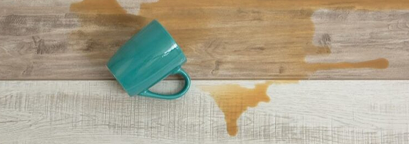
What Are the Best Laminate Floor Cleaners?
The best laminate floor cleaners are non-abrasive, natural, or PH-balanced. If you’re interested in DIY options, we’ve got 10+ homemade cleaning solution ideas for you to try. Before trying a new laminate floor cleaner, check the manufacturer’s recommendations.How Do You Maintain the Shine of Laminate Flooring?
Maintain your laminate by regularly sweeping and removing stains promptly to avoid staining. You should never wax or polish your laminate floor as its shiny appearance requires no additional solutions.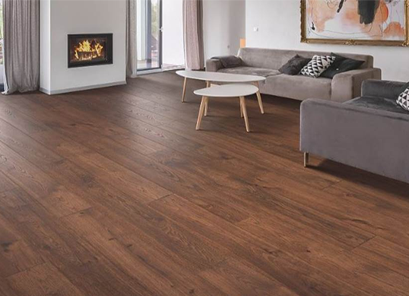
What Does Laminate Floor Peaking Mean?
Buckling, warping, and cupping of your laminate are often referred to as laminate “peaking.” Peaking happens when there is improper space for your laminate to expand and contract, if there is excessive moisture beneath, or if the environment is highly humid.Additionally, not enough space between the edges of the floor and walls can create buckling. If peaking is left uncorrected, your laminate floor can eventually lift off entirely.
How Do You Fix Laminate Flooring That Is Lifting?
If the peaking is not too severe, you can correct your laminate by adding expansion space.How to fix laminate floor peaking
- Start by removing the baseboards and finding the areas where flooring is locked into place.
- Remove the laminate planks, and cut them 3/8” shorter to allow expansion and contraction.
- Lay the flooring back down, and give two to three weeks for peaking to subside. If peaking persists, lay something heavy over the flooring for a while.
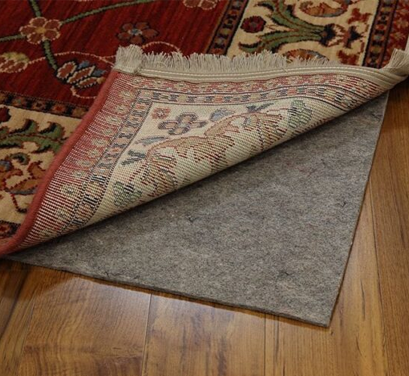
How Can I Prevent Scratches On My Laminate Flooring?
There are several preventative actions you can take to reduce scratches on your floors.- Place entrance mats at doorways.
- Remove shoes – especially heels and cleats.
- Apply felt pads underneath all furniture to avoid scraping.
- Never drag or push objects across the floor – ask for help to pick them up instead.
- Add area rugs throughout the space for added protection and style
- For rolling chairs, attach rubber wheels to them.
How Can I Remove Scratches On My Laminate Flooring?
Laminate flooring is durable and great for high-traffic areas; however, scrapes and damage are inevitable after years of use. Below are some quick DIY fixes to reduce the appearance of scratches on your laminate.- Use touch-up markers- they’re great for very fine, superficial scratches on your laminate flooring. Also, touch-up markers are a speedy and cost-effective way to clean up the small areas of your laminate without fully repairing them
- For deeper scratches and dents, use wood wax. Check the manufacturer for wax filler sticks that match the exact color of your laminate flooring. You can quickly fill in the scratches by melting the wax and applying it to sections of your laminate floor.
- Colored putty kits are another option that works great to fill deep imperfections. This option requires buffing the area and precision to apply the putty evenly for a flawless finish. Make sure to check with the manufacturer for kit availability.
Laminate Flooring Costs

For starters, laminate is an excellent choice for those who don’t want to sacrifice style, durability, or affordability when buying new floors. Most of our laminate options can be DIY installed as floating floors, bringing down the overall cost.
How Much Does Laminate Flooring Cost?
The cost of laminate varies. The AC rating, installation type, and added benefits like waterproofing and scratch resistance impact the price. On average, laminate material costs between $1 to $4 per sqft. Consider it an investment with high-quality laminate, as it will require less maintenance over time compared to cheaper alternatives.If you’re looking for excellent quality and affordable recommendations, check out our staff picks for more laminate ideas!
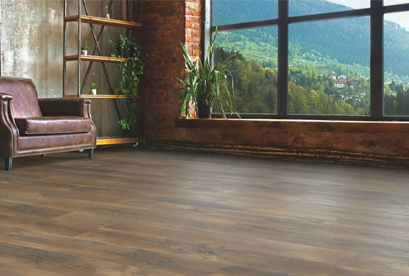
How Much Does It Cost to Install Laminate Flooring?
The installation cost depends on whether or not you want to do a DIY installation or have a professional installer lay your laminate.On average, the labor cost to install laminate ranges from $2 to $7 per sqft. Also, this labor cost usually covers the underlay and any adhesives needed throughout the installation process.
Does Laminate Flooring Add to a Home’s Resale Value?
Yes, laminate flooring can add to the resale value of a home. Depending on the quality of the laminate, it can be a great selling point to prospective home buyers.Tip: If you intend to renovate your home’s flooring before selling it, keep different flooring types to a minimum. Having too many clashing materials (carpet, tile, wood-look flooring, etc.) against one another can make things look cluttered.
Conclusion
We hope you’ve enjoyed learning about laminate flooring and received helpful answers and advice to questions you may have. Ready to start shopping?
Ready to shop?
Ready to shop?

